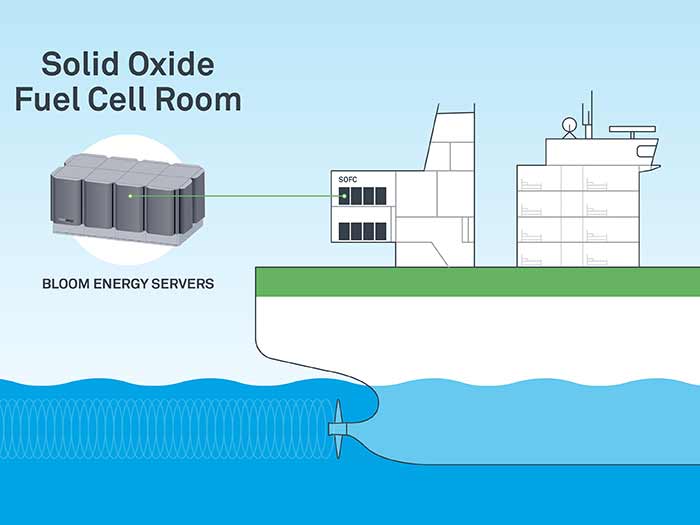
Samsung Heavy and Bloom Energy plan fuel cell powered Aframax
Written by Nick Blenkey
Modularity of Bloom Energy Servers makes them well suited to the space constraints of ship
San Jose, Calif., headquartered Bloom Energy, the world’s leading provider of stationary fuel cells. has announced a collaboration with shipbuilder Samsung Heavy Industries (SHI), to design and develop ships powered by Bloom Energy’s solid oxide fuel cell technology.
The two companies have already taken an important first step towards commercializing the maritime use of fuel cells for propulsion and auxiliary power. Samsung Heavy has received Approval in Principle from DNV GL to proceed with a fuel cell-powered ship design for Aframax crude oil tankers (COTs) in collaboration with Bloom Energy .
“As regulations to reduce GHG emissions take effect step-by-step, the introduction of fuel cells to vessels is inevitable. This approval, and being the first shipbuilder to secure this marine fuel cell technology, illustrates that Samsung Heavy is highly likely to lead the market,” said Kyunghee Kim, vice president of SHI Outfitting Engineering Team.
“It is a meaningful GHG emissions reduction measure to apply Bloom Energy’s fuel cell system to SHI’s new Aframax design. SHI’s new Aframax design is equipped with a new generating system in combination of the conventional, generator engines, and the new fuel cell technology, both fueled with LNG,” said Hwa Lyong Lee, vice president of Regional Business Development, Maritime at DNV GL. “This innovative design is one of the ways to improve GHG emissions, to further make LNG a solid and long-term solution.”
In contrast to bunker fuel combustion, Bloom Energy solid oxide fuel cells generate electric power through an electrochemical reaction, without combustion, that virtually eliminates particulate emissions, NOx, and SOx – an important consideration for the shipping industry.
Bloom Energy Servers use natural gas, biogas or hydrogen as fuel. Bloom Energy and SHI envision onboard fuel cells being powered by natural gas, converted from liquefied natural gas (LNG), which is already commonly transported by marine shipping worldwide.
Bloom Energy recently announced the capability of its fuel cells to run on hydrogen. As nations and ports develop hydrogen infrastructures, fuel cell-powered ships could transition from natural gas fuel to hydrogen fuel and become zero-carbon and zero-smog emitters.
The modularity of Bloom Energy Servers makes them well suited to the space constraints of ships. Bloom Energy Servers can be deployed in increments as small as 200 kilowatts, enabling power sources to be distributed throughout a ship to optimize space utilization. SHI envisions Bloom Energy Servers displacing existing power generation sets, and therefore requiring no additional space, or even reducing the total space required for power generation.




